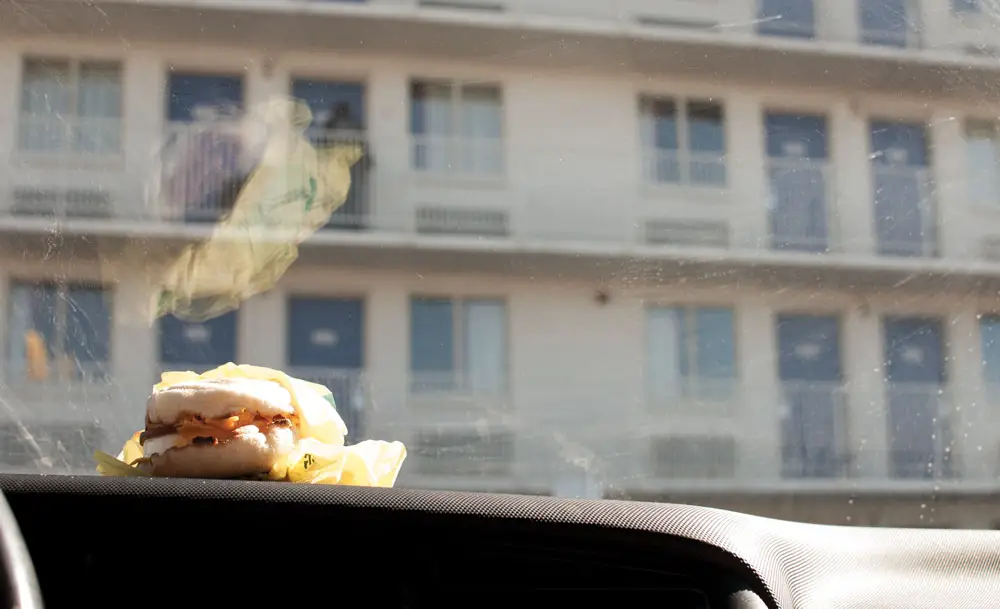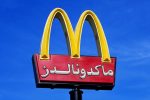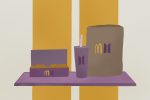It occurred to me while I was eating my McMuffin on a muggy Tuesday night in a speckled McDonald’s booth, that there were two basic points of comparison between McDonald’s newly-minted All Day Breakfast Menu and the writer Franz Kafka.
Later, another point of comparison struck me after re-reading “Laughing with Kafka,” an essay taken from a speech that David Foster Wallace gave, in which he talks about why it’s hard to understand Kafka’s humor.
Here are the three similarities.
Bugs
Despite the strong smell of chemical cleaners (a reverse barometer of a place’s resting state of hygiene: The more clean a place smells, the dirtier it is), I saw several bugs during my meal at McDonald’s.
When my friends and I visited the restaurant, it was well into November and the “It’s Texas There’s Bugs” alibi that holds water during the summer was way past its expiration date.
Even though none of the bugs were cockroaches, which—though Kafka never uses the word—are typically what critics and illustrators assume the narrator changed into in The Metamorphosis, I still made the mental association. The critters didn’t affect my eating experience per se, and since endophagy is the Protein of the Future anyway, I’d long ago accepted creepy-crawlies into my heart and mouth as my larder saver.
But like the no-see-ums flitting around my head, my synapses started firing: bugs and Kafka are related because The Metamorphosis yes, but not exceptionally so—there are loads of other books buzzing with insect imagery. But there was another level of connection between Kafka and the Golden Arches, one that was a little more unique.
You see, the whole reason that I had decided to eat at McDonald’s that night was because the restaurant had just unveiled its new All Day Breakfast Menu, and that particular coincidence led me to think about poor Gregor Samsa.
The McMorphosis
In Kafka’s novel, Samsa wakes up one morning to find that he’s undergone a massive change that makes him nearly unrecognizable (he’s turned into a bug).
On Oct., 2015, McDonald’s awoke one morning to find that it too had undergone a massive change that had made it nearly unrecognizable (All Day Breakfast Menu). Neither metamorphosis, in retrospect, appears to have been entirely well received.
The menu, which debuted countrywide to enormous fanfare, abolished the 10:30am curfew on McDonald’s breakfast items that had stood (in most locations) since Kroc first introduced breakfast in 1972.
Though consumers had been clamoring for the cutoff’s abolition for years, McDonald’s had staunchly maintained that it was flat impossible to serve all-day breakfast.
They claimed that since the same equipment is used to cook both breakfast and dinner—deep-fat fryers for hash browns and fries, griddles for eggs and patties, etc.—it would be a logistical camel’s needle to offer both menus and still be as efficient as McDonald’s patrons had come to expect.
When the dinner rush hit, spokespeople explained, it would be a simple matter of thermal and spatial impossibility to serve both. And for more than 40 years, that was that.
But, as McDonald’s sales continued to drop, millennials continued to eat elsewhere, and the restaurant devolved more and more into what Boston ad agency Connelly Partners called “a piñata” brand, surprise, surprise—the restaurant suddenly found a way to make the impossible possible.
There are several important caveats to their raising of the spud limit though, the first and most flabbergasting of which is that many items that you know and love from the breakfast menu still aren’t served after 10:30am.
For instance, although McDonald’s spokeswoman Lisa McComb (who I assume was handpicked for her McSurname) has said that nearly 90 percent of locations are selling hash browns all day now, my neighborhood Mickey D’s didn’t offer them, nor—as the vitriol of Internet trolls would lead me to believe—do many other locations.
Even more damning is what the Nation’s Restaurant News called the “Biscuit-McMuffin line,” i.e. the metaphorical line separating the McMuffin-scarfing North and the biscuit-munching South. Because many locations have trouble serving both all day, McMuffins rule most of the country while the “Biscuit Belt” of the South is a McMuffin dead-zone.
Fortunately, my San Antonio location sold both, causing me to once again thank Sam Houston for situating Texas on the geopolitical fence, allowing it to pick and choose what exactly it wants to be Southern about.
In addition to glaring menu lacunae, the McMorphosis is a massive, risky maneuver on the business side of things, and some franchisees are worried about the long-term ramifications of unfettered breakfast.
A large reason for that concern is that breakfast foods on average cost less than dinner foods, so every customer who buys a McMuffin instead of a McChicken is actually dropping total McSales.
This means that McDonald’s runs the risk of cannibalizing its profitability for an increase in volume, a backwards business move that’s really only justified by the PR brownie points that come from appearing to listen to customer feedback.
What’s more, the all-day breakfast items not only diminish profit, they also push other, more profitable items off the plank: About half of the nation’s McDonald’s have axed McWraps to free up space for pancakes and eggs.
And therein lies the comparison: Like Samsa, not only has McDonald’s undergone a drastic, morning-time transition that’s startling and inexplicable—it’s kind of ugly.
What’s the point of turning into a bug if you still have a human conscience—a man’s mind in a bug’s body will never work. And just the same, what’s the point of putting breakfast items on the dinner menu if the options are limited, the bottom line suffers and fan favorites get chopped in the process?
Laughing with McDonald’s
At the end of his essay “Laughing with Kafka,” Wallace says to imagine Kafka’s art as a kind of door, where readers are:
“Coming up and pounding on this door, pounding and pounding, not just wanting admission but needing it, we don’t know what it is but we can feel it, this total desperation to enter, pounding and pushing and kicking, etc. That, finally, the door opens…and it opens outward: we’ve been inside what we wanted all along.”
Wallace’s point (if you’ll allow for a quick and heavy reduction) is that Kafka’s humor is hard for most Americans—yes, specifically Americans—to get, precisely because we’ve been trained to think that humor is something that you “get.”
In reality, enjoying a joke and understanding a joke are not entirely the same thing; case in point: there are few more effective ways to destroy humor than to dissect it (“Costello is mistaking the proper name “Who” for the interrogative pronoun “who,” etc.).
To further Wallace’s analogy, the food at McDonald’s is a door that isn’t really there to be opened. This is because—and here’s the thing—it kind of doesn’t matter. Bold claim to say that a restaurant’s food doesn’t matter, I know, but think about it. You don’t really go to McDonald’s expecting good food.
It’s there, to stretch the analogy a little further, just so you can knock on it.
Analyze too deeply, look too closely, knock too forcefully, and the door will open only to reveal that you’ve been inside what you wanted all along.
Luckily for my crippling buyer’s remorse, I only came to this conclusion weeks after I had ordered a McMuffin sans hash browns ($2.79), a Sausage Burrito ($1.19) and a 3 Hot Cakes with Sausage ($3.39).
The McMuffin, in all truthfulness, has long been my favorite item at McDonald’s, so I was particularly excited about its All Day Breakfast ribbon-cutting. Unfortunately, without hash browns, the McMuffin is not much more than a cute 5-bite snack.
The snack unpacked: The English muffin component of the McMuffin is far and away the best part of the sandwich. Even served at room temperature, there are few more rewarding textural contrasts than the muffins’ sandpapery tops, dusted with granular cornmeal, and their soft strands of sourdough cobwebs inside.
The egg product, cooked à la astronaut in a Teflon ring, tasted like Styrofoam made from meringue, and the salt Frisbee disguised as a ham slice must’ve been portioned by a pig trying to stretch its comrades’ sacrifice. The cheese, so sue me, I removed. Taken together—as it must be—the sandwich is perfectly balanced in taste and texture, and could only be improved by enlargement.
The Sausage Burrito tasted the way food scientists have engineered things to taste when they’re “Southwestern,” which means a grilled red-pepper sweetness tinged with what Tabasco would taste like if it were raised by tomato juice that held down two jobs.
The rubbery ham chunks, processed into jagged little polyhedrons, were the only thing that required chewing, as the scrambled egg slid clean down the throat hole as only baby-birded baby bird could do. The tortilla tasted like stiff tissue-paper cooked in cold air, and was the low point of the meal.
The 3 Hot Cakes had a similar papery quality, sticking around in my mouth just long enough to prove that they were there, while the sweet syrup and chemically-heightened pork taste of the pork sausage reminded me of the food that you eat when you’re camping that makes you miss regular food.
Call it the experience of McDonald’s, or the comfort of McDonald’s, or the nostalgia or the convenience or whatever idea you want to affix the specific appeal of McDonald’s to, but one thing’s certain: You don’t go to Mickey D’s because of its Michelin stars. The food isn’t there to be “gotten.”
We are talking, if you remember, about the most internationally lampooned restaurant in the world, the business that experts refer to as a “piñata” brand.
A restaurant that serves food so inorganic and alien that mom-blogs have achieved deep Internet fame for photographing and chronicling its Chernobylesque rates of decomposition.
And understanding that irony, understanding that the pleasure of McDonald’s is in the door-knocking and not the door-opening, is critical to realizing why the humor of it all is so perfectly Kafkaesque: McDonald’s, the most successful restaurant in the entire history of humanity, serves the worst food in the world. Das ist komisch.
















